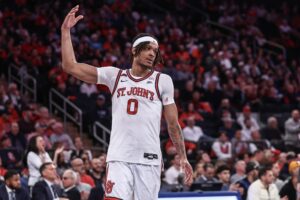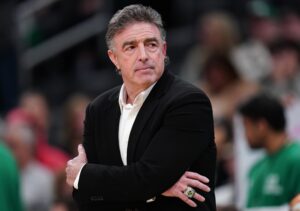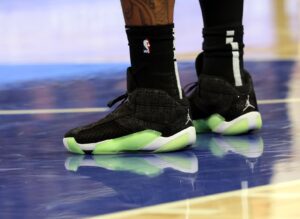Heading into the summer of 2019, the potential was there for a landscape-altering free agency, as well as an entertaining one. Suffice to say, it succeeded at both. Now that the dust has settled on free agency 2019, a sense of parity is starting to form around the league. Fans of the NFL are familiar with the term, the belief that any given year a large number of teams have a chance at winning the title. Parity has been rare in the NBA, where most of its history has been dominated by dynasties. Now it’s returned and with it a new, different kind of excitement.
Free Agency 2019 Re-established Parity in the NBA
The Rise and Dominance of Superteams
For the last 10 plus years, superteams have ruled the NBA. A superteam can generally be defined as any team with three of the best 20 players in the league. Though the history of superteams dates back decades, most recently the term came back with the 2007-2008 Boston Celtics. Celtics GM Danny Ainge brought in Kevin Garnett and Ray Allen to play alongside Paul Pierce. They won the title that year, validating the model. In 2010, LeBron James and Chris Bosh famously teamed up with Dwyane Wade on the Miami Heat to form the next. When James returned to the Cleveland Cavaliers in 2014, he formed another with Kyrie Irving and Kevin Love. Finally, in 2016 Kevin Durant joined the Golden State Warriors to create the greatest superteam of them all.
The problem with superteams is they wreck the competitive balance of the league. In an 82-game season, there’s little chance a superteam won’t make the playoffs. Once there, the playoffs are a best-of-seven series so that the better team usually wins. While chemistry and coaching certainly play big factors, talent can mask all that and is usually the biggest factor in determining who wins. Superteams by their definition, are a collection of the best talent in the league. With all that talent concentrated on less than a handful of teams, the rest of the league is effectively out of title contention.
This has been the state of the NBA for the last 10 years, where every other team was trying to create a superteam or waiting for them to be over. As one fell, another rose to take its place. There was optimism superteams might fade out this summer, but there was also the potential it could continue.
The Fall of Superteams
Going into free agency 2019, it wasn’t a given that superteams would die out. The Warriors were going to try to persuade Durant to stay and continue their dynasty. Fresh off an Anthony Davis trade, the Los Angeles Lakers had plans to get a third superstar to pair with Davis and James. Out East, the Philadelphia 76ers wanted to convince Jimmy Butler and Tobias Harris to run it back. There was a good possibility one or more superteams would continue to prevent true parity in the league again.
As things played out, though, things didn’t end go as expected. Durant left Golden State to team up with Irving on the Brooklyn Nets. The Lakers never found their third star and instead had to pivot to using their money for a supporting cast. The 76ers kept Harris but Butler turned them down to instead go to the Miami Heat. Kawhi Leonard opted out of forming a superteam with the Lakers to instead go the Los Angeles Clippers after forcing a Paul George trade there.
In the wake of free agency, the fall of superteams has finally come. While there are certainly teams with more talent and a better title chance than others, none have the requisite collection of talent to be considered a superteam. At least for now, there’s a sense of parity finally returning to the league.
The New Era of Duos and Depth
While hoarding the best players is still the best way to win, the 2019 playoffs did show potentially the next best option. The Toronto Raptors won the title because they had Leonard as the primary star, Kyle Lowry or Pascal Siakam trading turns as the secondary star, and a deep supporting cast around them. If three stars aren’t available, two and depth behind them is a good substitute. It’s also easier to replicate for more teams across the league.
Duos have become prominent in the West. The Clippers have Leonard and George, while the Lakers have James and Davis. The Houston Rockets recently reunited Russell Westbrook and James Harden. The Portland Trail Blazers have had Damian Lillard and CJ McCollum for years. The Denver Nuggets have homegrown stars Nikola Jokic and Jamal Murray. The Warriors still have Stephen Curry and Klay Thompson, with Draymond Green and D’Angelo Russell backing them up.
Out East, teams are either going with two stars or deeper rosters. The Milwaukee Bucks re-signed Khris Middleton to play alongside reigning MVP Giannis Antetokounmpo and kept most of their depth. The 76ers are arguably the closest the league has to a superteam with Harris, Ben Simmons, Joel Embiid, and Al Horford. However, there are serious concerns for each player. The Celtics signed Kemba Walker and hope Gordon Hayward can return to form. Meanwhile, they’ve still got a talented young roster. The Indiana Pacers have Victor Oladipo and a deep roster. Even the Heat have Butler and depth as well.
A Welcome Return to Parity
Superteams are fun for their fanbases but are terrible for fanbases of other teams and the general NBA fan. That kind of certainty ruins the drama or suspense of wondering who will win the championship. The Warriors put the league in an existential crisis for the last three years after signing Durant. It was all but inevitable that they would win the title. Were it not for key injuries to Durant and Thompson, they arguably would have won three in a row.
With the Warrior’s dynasty over and the lack of a superteam rising to take its place, the league feels wide open for the first time in years. There are four to five teams in each conference that have a legitimate shot to make the Finals and then have a chance to win the 2020 title. There’s now plenty of speculation and enthusiasm for next season for more than a handful of teams, which is great for the NBA. The 2019 free agency could have continued the superteam trend, but thankfully it ended with a return to parity.
Main Photo
Embed from Getty Images






